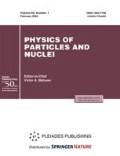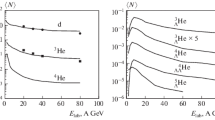Abstract
To provide the computer simulation support to the new experimental facilities BM@N and MPD at the accelerator complex NICA we performed an upgrade of the Monte Carlo generator DCM-QGSM and developed a new generator, DCM-SMM, on the basis of the Dubna cascade model (DCM). The generators aimed to simulate particle–nucleus and nucleus–nucleus collisions in a wide range of energy and thus can serve as an effective tool for analysis of physical effects. A particularity of the generators is their capability to simulate nuclear fragments.





Similar content being viewed by others
REFERENCES
V. D. Toneev and K. K. Gudima, “Particle emission in light and heavy ion reactions,” Nucl. Phys. A 400, 173–190 (1983).
V. D. Toneev, N. S. Amelin, K. K. Gudima, and S. Yu. Sivoklokov, “Dynamics of relativistic heavy ion collisions,” Nucl. Phys. A 519, 463–478 (1990).
N. S. Amelin, K. K. Gudima, and V. D. Toneev, “Quark–gluon string model and ultrarelativistic heavy ion interactions,” Sov. J. Nucl. Phys. 51, 327–333 (1990).
N. S. Amelin, K. K. Gudima, and V. D. Toneev, “Ultrarelativistic nucleus-nucleus collisions within a dynamical model of independent quark–gluon strings,” Sov. J. Nucl. Phys. 51, 1093–1101 (1990).
N. S. Amelin, K. K. Gudima, S. Yu. Sivoklokov, and V. D. Toneev, “Further development of a quark–gluon string model for describing high-energy collisions with a nuclear target,” Sov. J. Nucl. Phys. 52, 172–178 (1991).
N. S. Amelin and L. V. Bravina, “The Monte Carlo realization of quark–gluon string model for description of high-energy hadron hadron interactions,” Sov. J. Nucl. Phys. 51, 133–140 (1990).
J. P. Bondorf, A. S. Botvina, A. S. Iljinov, I. N. Mishustin, and K. Sneppen, “Statistical multifragmentation of nuclei,” Phys. Rep. 257, 133–221 (1995).
A. B. Kaidalov, “Quark and diquark fragmentation functions in the model of quark–gluon strings,” Sov. J. Nucl. Phys. 45, 902–907 (1987).
H. Schulz, G. Röpke, K. K. Gudima, and V. D. Toneev, “The coalescence phenomenon and the Pauli quenching in high-energy heavy-ion collisions,” Phys. Lett. B 124, 458–460 (1983).
J. Steinheimer, K. Gudima, A. Botvina, I. Mishustin, M. Bleicher, and H. Stöcker, “Hypernuclei, dibaryon and antinuclei production in high energy heavy ion collisions: Thermal production versus coalescence,” Phys. Lett. B 714, 85–91 (2012).
A. S. Botvina, J. Steinheimer, E. Bratkovskaya, M. Blei-cher, and J. Pochodzalla, “Formation of hypermatter and hypernuclei within transport models in relativistic ion collisions,” Phys. Lett. B 742, 7–14 (2015).
T. Anticic et al. (NA49 Collab.), “Production of deuterium, tritium, and 3He in central Pb + Pb collisions at 20A, 30A, 40A, 80A, and 158A GeV at the CERN SPS,” Phys. Rev. B 94, 044 906 (2016).
E. Fermi, “High-energy nuclear events,” Prog. Theor. Phys. 5, 570–583 (1950).
S. Furihata, “Statistical analysis of light fragment production from medium energy proton-induced reactions,” Nucl. Instrum. Methods Phys. Res., Sect. B 171, 251–258 (2000);
S. Furihata, “Development of a generalized evaporation model and study of residual nuclei production,” PhD Thesis (Tohoku University, Sendai, 2003).
A. S. Botvina, I. N. Mishustin, M. Begemann-Blaich, et al., “Multifragmentation of spectators in relativistic heavy ion reactions,” Nucl. Phys. A 584, 737–756 (1995).
Xi Hongfei, T. Odeh, R. Bassini, et al., “Breakup temperature of target spectators in Au-197 + Au-197 collisions at E/A = 1000 MeV,” Z. Phys. A 359, 397–406 (1997).
R. Ogul et al. (ALADIN Collab.), “Isospin-dependent multifragmentation of relativistic projectiles,” Phys. Rev. C 83, 024608 (2011).
T. Ahmad and M. Irfan, “Inelastic interactions caused by 4.5A GeV/c carbon and silicon nuclei,” Nuov. Cim. A 106, 171–185 (1993).
A. S. Botvina, K. K. Gudima, and J. Pochodzalla, “Production of hypernuclei in peripheral relativistic ion collisions,” Phys. Rev. C 88, 054605 (2013).
M. Baznat, A. S. Botvina, G. Musulmanbekov, V. D. Toneev, and V. Zhezher, “Monte-Carlo generator for heavy ion collisions DCM-SMM,” PEPAN Lett. 17 (3), 265 (2020).
S. Afanasiev et al. (NA49 Collab.), “The NA49 large acceptance hadron detector,” Nucl. Inst. Meth. Phys. Res., Sect. A 430, 210 (1999).
Funding
The work has been performed in the framework of the project 18-02-40084 supported by Russian Foundation for Basic Research grant “Megascience NICA”.
Author information
Authors and Affiliations
Corresponding author
Rights and permissions
About this article
Cite this article
Musulmanbekov, G., Zhezher, V. Simulation of Nuclear Fragments in Heavy Ion Collisions by Monte Carlo Generators. Phys. Part. Nuclei 52, 598–603 (2021). https://doi.org/10.1134/S1063779621040456
Received:
Revised:
Accepted:
Published:
Issue Date:
DOI: https://doi.org/10.1134/S1063779621040456



